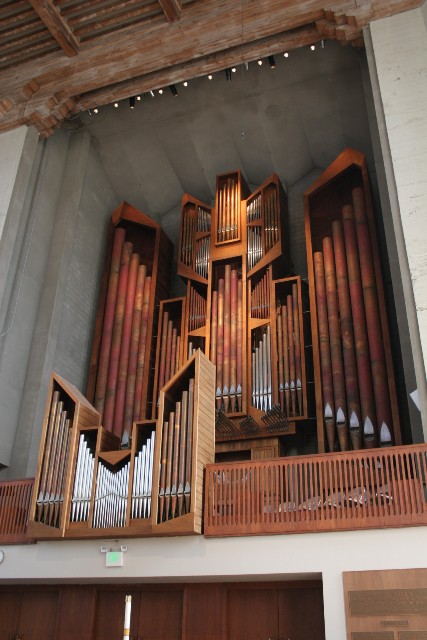|

D. A. Flentrop - 1965
Paul Fritts & Co., Organ Builders - 1992/95 renovation
4 Manuals & Pedals 58 Stops/79 Ranks 3,944 Pipes
One of the most extraordinary things about the organ at St. Mark’s is the fact that it sits in an Episcopal cathedral. Built in 1965 by the Dirk Flentrop Orgelbouw of Zandaam, Holland, the instrument represents that decade’s best understanding of 18th century North European organ building. The Flentrop organ was designed for playing Bach and accompanying the robust singing typical of Calvinist and Lutheran congregations. On the other hand, the English organ evolved primarily to accompany choirs. Such an instrument could create a constantly changing orchestral accompaniment that never took front stage before the precious Anglican boy choir. When Peter Hallock chose an organ designed primarily for playing the music of Bach, he broke new ground for an Anglican cathedral. So controversial was the decision that the dean of St Mark’s wrote to other prominent Episcopal cathedral organists to garner their opinions on the choice. All except one responded that the instrument was a serious mistake. But Dean Leffler took the suggestion of Vernon deTar, who said, “Just go with the advice of your musician- after all, he’s one of the best in the country.” The presence of this new instrument meant a reinterpretation of the English anthem repertoire, and inspired new anthems written squarely in that tradition by Hallock himself. Consequently, Hallock’s anthems sound at home when accompanied by the characteristic sound of St. Mark’s Flentrop organ, as recorded in this collection. St. Mark’s Flentrop is one of the largest 20th century organs employing mechanical (“tracker”) key action, and its success has influenced organ building throughout the United States. It remains a “landmark instrument” of international note.
Stop List (Note: Boldface Type indicates new work completed in 1992/1995)
Hoofdwerk II - 56 notes
16 Prestant
8 Prestant
8 Roerfluit
4 Octaaf
4 Speelfluit
2-2/3 Quint
2 Octaaf
1-3/5 Terts
IV Mixtuur (224 Pipes)
III Scherp (186 Pipes)
16 Trompet
8 Trompet
16 Trompet (horizontal)
8 Trompet (horizontal)
Rugwerk I - 56 notes
8 Prestant
8 Gedekt
8 Quintadeen
4 Octaf
4 Roerfluit
2 Octaaf
II Sesquialter (112 Pipes)
III Mixtuur (168 Pipes)
III Scherp (168 Pipes)
16 Dulciaan
8 Schalmei
- Tremulant
Bovenwerk III (Swell*) 56 notes
8 Prestant
8 Fluit
8 Gemshoorn
8 Zweving (44 Pipes)
4 Octaaf
4 Koppelfluit
2-2/3 Nasard
2 Flageolet
1 Octaaf
V Mixtuur (280 Pipes)
8 Trompet
8 Kromhoorn
- Tremulant
*Mechanically Operated Swell Shutters
Borstwerk IV - 56 notes
8 Gedekt (wood)
4 Prestant
4 Fluit
2 Gemshoorn
1-1/3 Larigot
II Cymbel (112 Pipes)
8 Regaal
- Tremulant
Pedaal - 32 notes
32 Prestant (12 + 20 from 16')
16 Prestant
16 Subbas (wood)
8 Octaaf
4 Octaaf
8 Gedekt
4 Spitsgedekt
2 + 1 Nacthoorn (64 Pipes)
VII Mixtuur (224 Pipes)
32 Bazuin (8w/24m)
16 Bazuin
8 Trompet
4 Trompet
2 Cornet
Zymbelstern
Suspended key action and electric stop action
Solid state combination action (255 memory levels)
Couplers and general pistons duplicated on toe studs.
Couplers II + I II + III I + III Ped + I (Rugwerk) Ped + II (Hoofdwerk) Ped + III (Bovenwerk)
Combinations
6 Combinations per Division
8 General Pistons
1 General Cancel
1 Setter Position
|